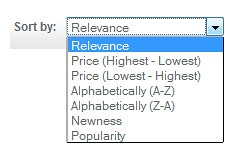
Search optimisation is a well-discussed and documented marketing strategy to increase the visibility of your site and help customers find you.
But when we talk about search, most marketers focus their energy and investment in optimising content keywords, search engine ranking positions (SERP) and often overlook the power of an effective on site search engine.
To really make it work, it's important to decide what your onsite search strategy is:
- Are you looking to index unstructured content to give rapid search results and improve navigation?
- What content do you have and how advanced do the search filters need to be?
Content first
A good strategy starts with a solid understanding of your content and how customers use your site, and then you can decide how your content can be retrieved to get you the best possible conversion rate.
Effective site search is not just important but almost essential for online retailers, travel agents and real estate brokers, for example, where web visitors require specific information and personalised criteria for their search in order to make a buying decision.
This is about delivering the most relevant and personalised information as quickly and easily as possible for visitors. Most customers know what they want to buy and don't want to browse and navigate through the entire site, so search functions can significantly enhance the overall customer experience and drive sales.
Giving the customer what they want
For example, people searching for a summer holiday online will have specific needs and will want a personalised package to suit their preference in terms of budget, holiday type, location, time period and airlines.
If your site cannot guide visitors to the information they need within a few clicks you are unlikely to keep them on the site as competition is fierce.
So when developing an onsite strategy you should consider the following functions:
- Ease of use. Make it easy for customers to refine their search criteria such as product colour and size, auto complete for the search terms, and the ability to cope with misspellings and support result sorting based on price and distance, for example.
- Multichannel search. The ability to pull content from your website, including user-generated content and related social media activity will enhance the richness of your search results and help to drive product sales through customer reviews and ratings.
- Search in document. Apart from the actual data and merchandise on your site you may want to enable search in different formats such as Microsoft Word, PDFs, Apple iWorks, XML and video.
- Multi-language support. If your website operates globally you should make sure your onsite search is developed to support cross-border online setting and languages of the countries that you sell to.
- Geo search. The ability to index geographical coordinates and make them searchable is particularly useful for businesses with a shop front and to help drive footfall.
- Scalability. Ensure your onsite search engine is scalable as your product or merchandise range grows over time.
On-site search is an often overlooked but is a powerful way to improve customer experience and boost sales quickly on your website. In the long run, what you learn from onsite search analytics will also help you identify gaps and learn from customer behaviour for site refinement over time.
Maria Wasing is VP of Marketing Europe at EPiServer and a guest blogger on Econsultancy.
No hay comentarios:
Publicar un comentario